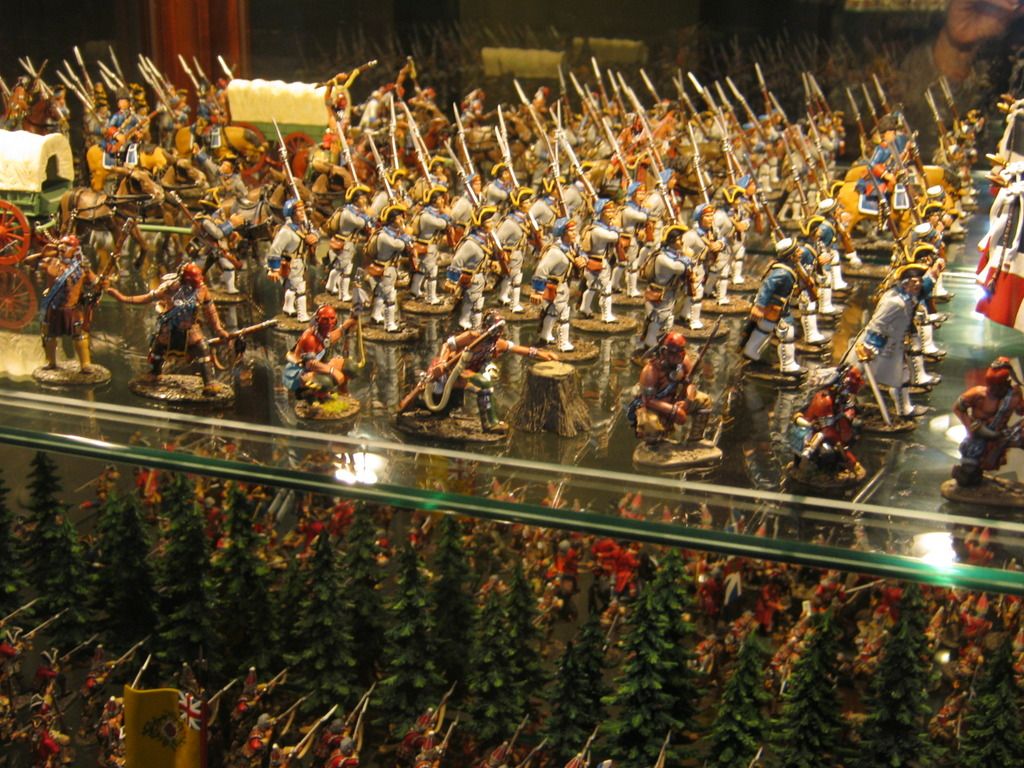Ltn. Col. Étienne-Guillaume de Senezergues, Regiment de La Sarre (JJD Club Set 22). Lead by de Senezergues, a company of the 2nd Battalion of the La Sarre Regiment plus a small detachment from the 2nd Battalion of the Languedoc Regiment with an escort of allied Indian warriors head south towards Ticonderoga. Montcalm had 18 Indian allies at Ticonderoga, so 18 warriors are included in the front row. Sergeant and corporal ranks would be indicated on the cuffs, and in the case of the sergeant, it would be a narrow gold or silver braid at the top of the cuff. Corporals had a braiding pattern on their cuffs as well, but the identification pattern varied by regiment.
During the French and Indian War, the French in Canada did not have the manpower to increase the strength of individual battalions. They were nearly always under strength at a maximum of about 500 men per battalion and often at 100 or so men less. When deployed for war, the British routinely packed individual companies with many more privates to increase the strength of the battalion, so that there were often 750 men per battalion. Scottish battalions could exceed 1,000 men. As such, French companies are generally much smaller in size their British counterparts.
Except for the two Berry Battalions originally organized for deployment to India, Montcalm's Army was organized as 13 companies per battalion, not 18 companies per battalion as in metropolitan France. British battalions kept the company size at 10.
From then Seven Years War Page: French Army Infantry Organization
http://www.kronoskaf.com/syw/index.php?title=French_Infantry_Organisation
A fusilier (battalion "hat") company of regular infantry battalions consisted of 42 men:
• 1 captain
• 1 lieutenant
• 2 sergeants
• 3 corporals
• 3 lance corporals (ansepessades')
• 31 fusilier
• 1 drummer
A company of grenadiers consisted of 48 men:
• 1 captain
• 1 lieutenant
• 1 sub-lieutenant
• 2 sergeants
• 3 corporals
• 3 lance corporals (ansepessades')
• 36 grenadiers
• 1 drummer
In the mid-18th century, the word "company" was considered as the administrative designation with word "platoon" saved for the tactical applications. So simplified, 1 platoon = 1 company. This holds true for the British as well. In modern armies, a platoon is much smaller than a company, but not in the mid-18th Century.
As the French lost the Seven Years War, they were motivated to correct the deficiencies exposed and moved quickly to reform their army. In France, many books and manuals were written, criticized and debated, and rewritten over a period of the next 35 years in time for the rise of Napoleon. By 1763, the number of companies per battalion was reduced to eight with 1 additional company of grenadiers. The eight fusilier companies were to have a strength of three officers and 63 enlisted men with the single grenadier company having three officers but only 52 men. A battalion would then be 28 officers (counting a sub-assistant major) and 556 enlisted men. The organization was then much closer to the British System, but not identical.










During the French and Indian War, the French in Canada did not have the manpower to increase the strength of individual battalions. They were nearly always under strength at a maximum of about 500 men per battalion and often at 100 or so men less. When deployed for war, the British routinely packed individual companies with many more privates to increase the strength of the battalion, so that there were often 750 men per battalion. Scottish battalions could exceed 1,000 men. As such, French companies are generally much smaller in size their British counterparts.
Except for the two Berry Battalions originally organized for deployment to India, Montcalm's Army was organized as 13 companies per battalion, not 18 companies per battalion as in metropolitan France. British battalions kept the company size at 10.
From then Seven Years War Page: French Army Infantry Organization
http://www.kronoskaf.com/syw/index.php?title=French_Infantry_Organisation
A fusilier (battalion "hat") company of regular infantry battalions consisted of 42 men:
• 1 captain
• 1 lieutenant
• 2 sergeants
• 3 corporals
• 3 lance corporals (ansepessades')
• 31 fusilier
• 1 drummer
A company of grenadiers consisted of 48 men:
• 1 captain
• 1 lieutenant
• 1 sub-lieutenant
• 2 sergeants
• 3 corporals
• 3 lance corporals (ansepessades')
• 36 grenadiers
• 1 drummer
In the mid-18th century, the word "company" was considered as the administrative designation with word "platoon" saved for the tactical applications. So simplified, 1 platoon = 1 company. This holds true for the British as well. In modern armies, a platoon is much smaller than a company, but not in the mid-18th Century.
As the French lost the Seven Years War, they were motivated to correct the deficiencies exposed and moved quickly to reform their army. In France, many books and manuals were written, criticized and debated, and rewritten over a period of the next 35 years in time for the rise of Napoleon. By 1763, the number of companies per battalion was reduced to eight with 1 additional company of grenadiers. The eight fusilier companies were to have a strength of three officers and 63 enlisted men with the single grenadier company having three officers but only 52 men. A battalion would then be 28 officers (counting a sub-assistant major) and 556 enlisted men. The organization was then much closer to the British System, but not identical.










Last edited:






